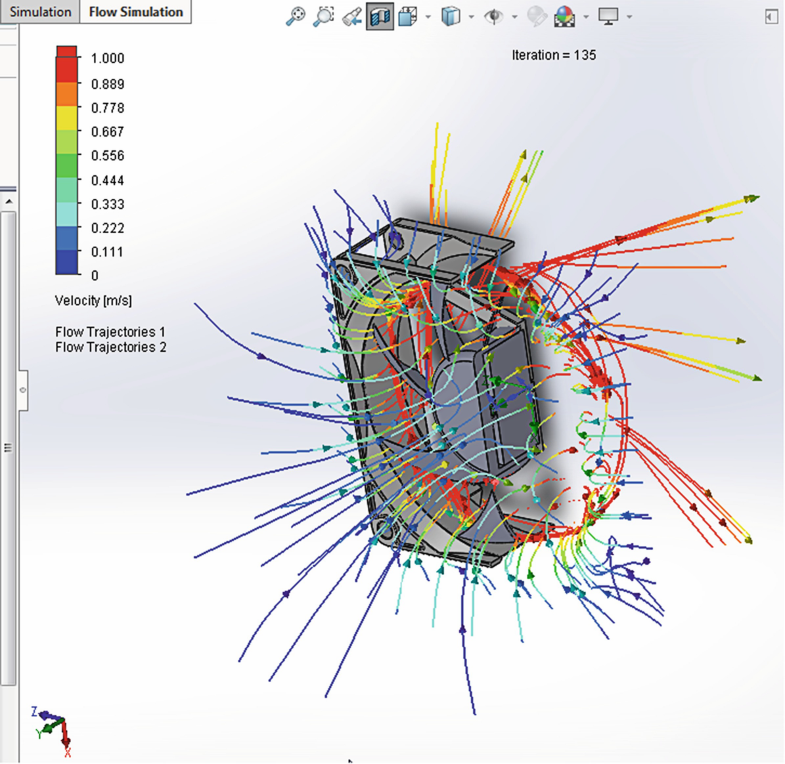

CFD study of propeller can be used study its different problem like propeller induced vibration, tip erosion, propeller cavitation, singing propeller, etc.

Three, four, or five blades are most common in marine propellers, although designs which are intended to operate at reduced noise will have more blades. An actual marine propeller is made up of sections of helicoidal surfaces which act together 'screwing' through the water (hence the common reference to marine propellers as "screws"). The ideal efficiency of any size propeller (free-tip) is that of an actuator disc in an ideal fluid. To study effect of change in material with composite material, in overall efficiency of marine propeller.Ī propeller is the most common propulsor on ships, imparting momentum to a fluid which causes a force to act on the ship.
#Solidworks flow simulation propeller software
To simulate experimental test in Emerson paper, numerically using commercial Software ANSYS Fluent 18.0 Smith quickly built a small model boat to test his invention, which was demonstrated first on a pond at his Hendon farm, and Smith was first to take out a screw propeller patent on 31 May, while Ericsson, a gifted Swedish engineer then working in Britain, filed his patent six weeks later. In 1835, two inventors in Britain, John Ericsson and Francis Pettit Smith, began working separately on the problem. Their disadvantages are higher mechanical complexity and higher cost. Propeller dynamics, like those of aircraft wings, can be modelled by either or both Bernoulli's principle and Newton's third law.Ī marine propeller of this type is sometimes colloquially known as a screw propeller or screw, however there is a different class of propellers known as cycloidal propellers they are characterized by the higher propulsive efficiency averaging 0.72 compared to the screw propeller's average ofĪnd the ability to throw thrust in any direction at any time. A pressure difference is produced between the forward and rear surfaces of the aero foil-shaped blade, and a fluid (such as air or water) is accelerated behind the blade. Smith would subsequently file a revised patent in keeping with this accidental discovery.Ī propeller is a type of fan that transmits power by converting rotational motion into thrust.

By a fortuitous accident, the wooden propeller of two turns was damaged during a voyage in February 1837, and to Smith's surprise the broken propeller, which now consisted of only a single turn, doubled the boat's previous speed, from about four miles an hour to eight. Having secured the patronage of a London banker named Wright, Smith then built a 30-foot, 6- horsepower canal boat of six tons burthen called the Francis Smith, which was fitted with a wooden propeller of his own design and demonstrated on the Paddington Canal from November 1836 to September 1837. Later at the Royal Adelaide Gallery of Practical Science in London, where it was seen by the Secretary of the Navy, Sir William Barrow. KeywordsHydroEnergy, Optimization, FSI interaction, Blade design, CFD analysis, Marine Propeller, Advance coefficient, Torque, Torque coefficient, Material, Convergence, etc. The acquired results are used as input data to carry out stress analysis on propellers made of three composite materials namely carbon composite, alumina composite and polymer composite. Reasonable results are produced such that the torque and efficiency trends will be in acceptable limits with respect to experimental data. The study is completed using a computational program, Ansys FLUENT, and velocity, pressure distribution, torque is compared to experimental results. Using SOLIDWORKS to recreate the geometry of a three- dimensional geometry, analysis was conducted. Tiwari College of Engineering, Mira Road, Thane, Maharashtra, IndiaĪbstractThis analysis of a propeller is based off the coordinates of model KCD 32 (Emerson and Sinclair, 1967). Performance Analysis and Enhancement of Marine Propellerīachelor of Engineering Student Department of Mechanical Engineering


 0 kommentar(er)
0 kommentar(er)
